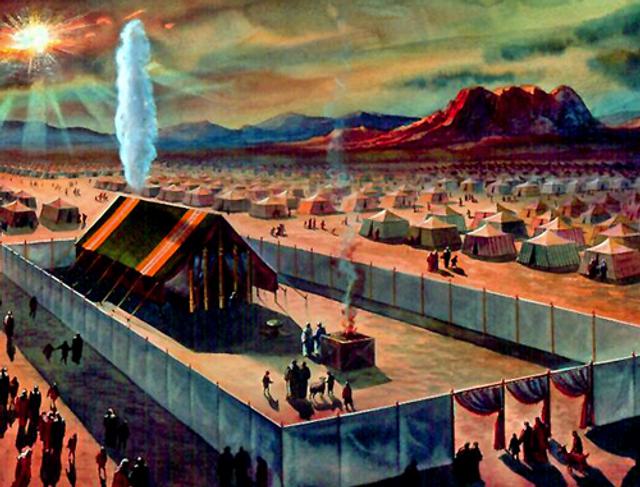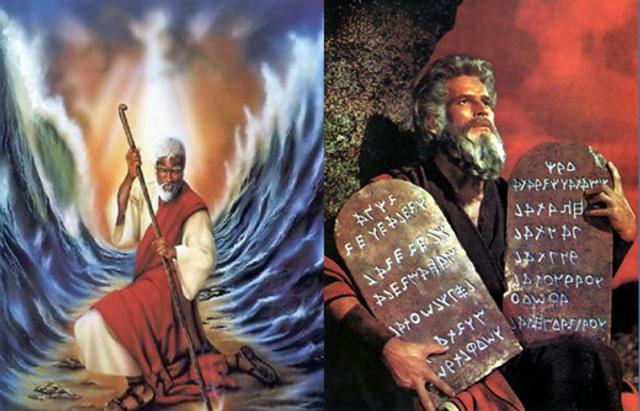Moses raises funds for the tabernacle – c. 1,500 BC
- Exhibited by
- Ian Clark (Church of England).
- Added
- June 08, 2010
- Medium of Communication
- Target Audience
- Volunteering.
- Type of Charity
- Religion related.
- Country of Origin
- Middle East.
- Date of first appearance
- circa 1500 BC.
SOFII’s view
This is now the oldest exhibit on SOFII (and will be, until you tell us different). It's also a surprisingly instructive fundraising case history. If you look at the detailed notes it becomes quite clear that the prophet Moses was an accomplished fundraiser who both understood his audience and appreciated the nuances of his fundraising proposition and how it would be received. In fact, the appeal so far exceeded target that Moses had to tell many of the enthusiastic volunteers to stop. Ian Clark has also very helpfully included a list of key lessons from this campaign. Though SOFII doubts if telling donors to bring in their onyx stones will be the next big thing in fundraising (except perhaps for charity shops...), we are sure that if this campaign were run today it would scoop every award going.
Creator / originator
The writer of the book of Exodus, the second book of the Torah and the Christian Bible, possibly originally the prophet Moses himself.
Summary / objectives
Moses wanted to get the materials and skilled volunteers to build a tabernacle (a travelling worship tent) for the Jews in the desert.
Background
The Jewish tribes were wandering in the Arabian deserts after they had fled from Egypt, probably about the fifteenth century before the birth of Christ.
Special characteristics
In the desert money was meaningless, so Moses got people to donate their possessions and skills.
Influence / impact
The tabernacle became a focal point for Jewish worship of God (Yaweh) for about 500 years.
Merits
The tabernacle became a focal point for Jewish worship of God (Yaweh) for about 500 years.
Other relevant information
The Jews had been slaves in Egypt, until God helped them to miraculously escape under the leadership of their greatest prophet Moses. They then wandered through the Arabian deserts for a long time (possibly 40 years). During this time, to continually remind them of God's presence, Moses started a fundraising campaign to build a tabernacle, a travelling meeting tent, in which the Jews could worship God. The story is told in the Book of Exodus in the Jewish scriptures (Torah) that people nowadays commonly know as the Old Testament. The story takes several chapters (35 to 40) to tell, including lots of detail about how the collection was used, and volunteers trained to help make the varied equipment for the tent and tabernacle. Relevant extracts are shown below.
Key learning points include:
- Moses gives the Jews a vision of what God wants.
- Moses suggests practical gifts (wood, precious metals, jewels, linens etc).
- Moses put skilled craftsmen in charge of specialist projects.
- Other volunteers were trained to help the skilled craftsmen/women
- The appeal raised more than enough resources, so Moses had to tell everyone to stop donating.
- The whole project took about a year to complete.
Fundraising for the tabernacle (extracts from the Christian Bible's book of Exodus 35, 36 and 40)
4 Moses said to the whole Israelite community, This is what the LORD has commanded:
5 From what you have, take an offering for the LORD. Everyone who is willing is to bring to the LORD an offering of gold, silver and bronze;
6 blue, purple and scarlet yarn and fine linen; goat hair;
7 ram skins dyed red and hides of sea cows; acacia wood;
8 olive oil for the light; spices for the anointing oil and for the fragrant incense;
9 and onyx stones and other gems to be mounted on the ephod and breastpiece.
10 All who are skilled among you are to come and make everything the LORD has commanded:
11 the tabernacle with its tent and its covering, clasps, frames, crossbars, posts and bases;
12 the ark with its poles and the atonement cover and the curtain that shields it;
13 the table with its poles and all its articles and the bread of the Presence;
14 the lampstand that is for light with its accessories, lamps and oil for the light;
15 the altar of incense with its poles, the anointing oil and the fragrant incense; the curtain for the doorway at the entrance to the tabernacle;
16 the altar of burnt offering with its bronze grating, its poles and all its utensils; the bronze basin with its stand;
17 the curtains of the courtyard with its posts and bases, and the curtain for the entrance to the courtyard;
18 the tent pegs for the tabernacle and for the courtyard, and their ropes;
19 the woven garments worn for ministering in the sanctuary— both the sacred garments for Aaron the priest and the garments for his sons when they serve as priests.
20 Then the whole Israelite community withdrew from Moses' presence,
21 and everyone who was willing and whose heart moved him came and brought an offering to the LORD for the work on the Tent of Meeting, for all its service, and for the sacred garments.
22 All who were willing, men and women alike, came and brought gold jewellery of all kinds: brooches, ear-rings, rings and ornaments. They all presented their gold as a wave offering to the LORD.
23 Everyone who had blue, purple or scarlet yarn or fine linen, or goat hair, ram skins dyed red or hides of sea cows brought them.
24 Those presenting an offering of silver or bronze brought it as an offering to the LORD, and everyone who had acacia wood for any part of the work brought it.
25 Every skilled woman spun with her hands and brought what she had spun— blue, purple or scarlet yarn or fine linen.
26 And all the women who were willing and had the skill spun the goat hair.
27 The leaders brought onyx stones and other gems to be mounted on the ephod and breastpiece.
28 They also brought spices and olive oil for the light and for the anointing oil and for the fragrant incense.
29 All the Israelite men and women who were willing brought to the LORD freewill offerings for all the work the LORD through Moses had commanded them to do.
30 Then Moses said to the Israelites, See, the LORD has chosen Bezalel son of Uri, the son of Hur, of the tribe of Judah,
31 and he has filled him with the Spirit of God, with skill, ability and knowledge in all kinds of crafts—
32 to make artistic designs for work in gold, silver and bronze,
33 to cut and set stones, to work in wood and to engage in all kinds of artistic craftsmanship.
34 And he has given both him and Oholiab son of Ahisamach, of the tribe of Dan, the ability to teach others.
35 He has filled them with skill to do all kinds of work as craftsmen, designers, embroiderers in blue, purple and scarlet yarn and fine linen, and weavers— all of them master craftsmen and designers.
1 So Bezalel, Oholiab and every skilled person to whom the LORD has given skill and ability to know how to carry out all the work of constructing the sanctuary are to do the work just as the LORD has commanded.
2 Then Moses summoned Bezalel and Oholiab and every skilled person to whom the LORD had given ability and who was willing to come and do the work.
3 They received from Moses all the offerings the Israelites had brought to carry out the work of constructing the sanctuary. And the people continued to bring freewill offerings morning after morning.
4 So all the skilled craftsmen who were doing all the work on the sanctuary left their work
5 and said to Moses, The people are bringing more than enough for doing the work the LORD commanded to be done.
6 Then Moses gave an order and they sent this word throughout the camp: No man or woman is to make anything else as an offering for the sanctuary. And so the people were restrained from bringing more,
7 because what they already had was more than enough to do all the work.
34 Then the cloud covered the Tent of Meeting, and the glory of the LORD filled the tabernacle.
35 Moses could not enter the Tent of Meeting because the cloud had settled upon it, and the glory of the LORD filled the tabernacle.
36 In all the travels of the Israelites, whenever the cloud lifted from above the tabernacle, they would set out;
37 but if the cloud did not lift, they did not set out— until the day it lifted.
38 So the cloud of the LORD was over the tabernacle by day, and fire was in the cloud by night, in the sight of all the house of Israel during all their travels
 View original image
View original image
 View original image
View original image
 View original image
View original image
















